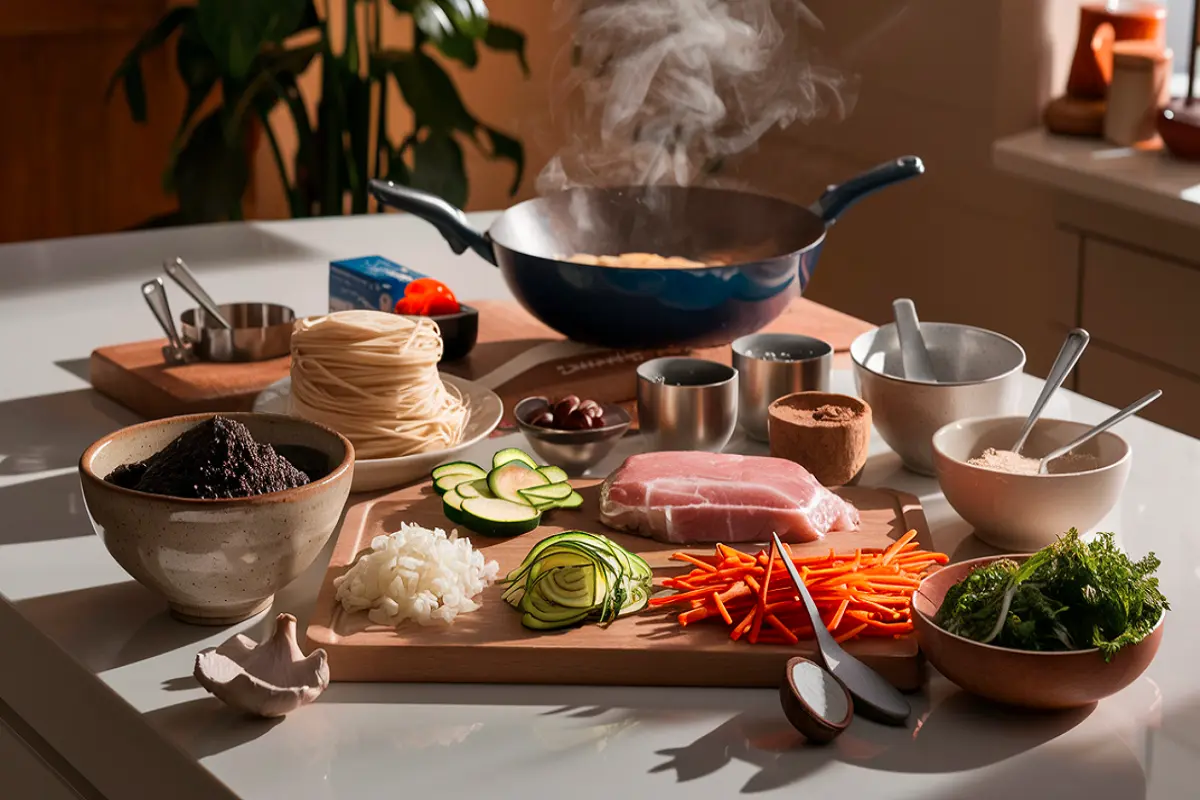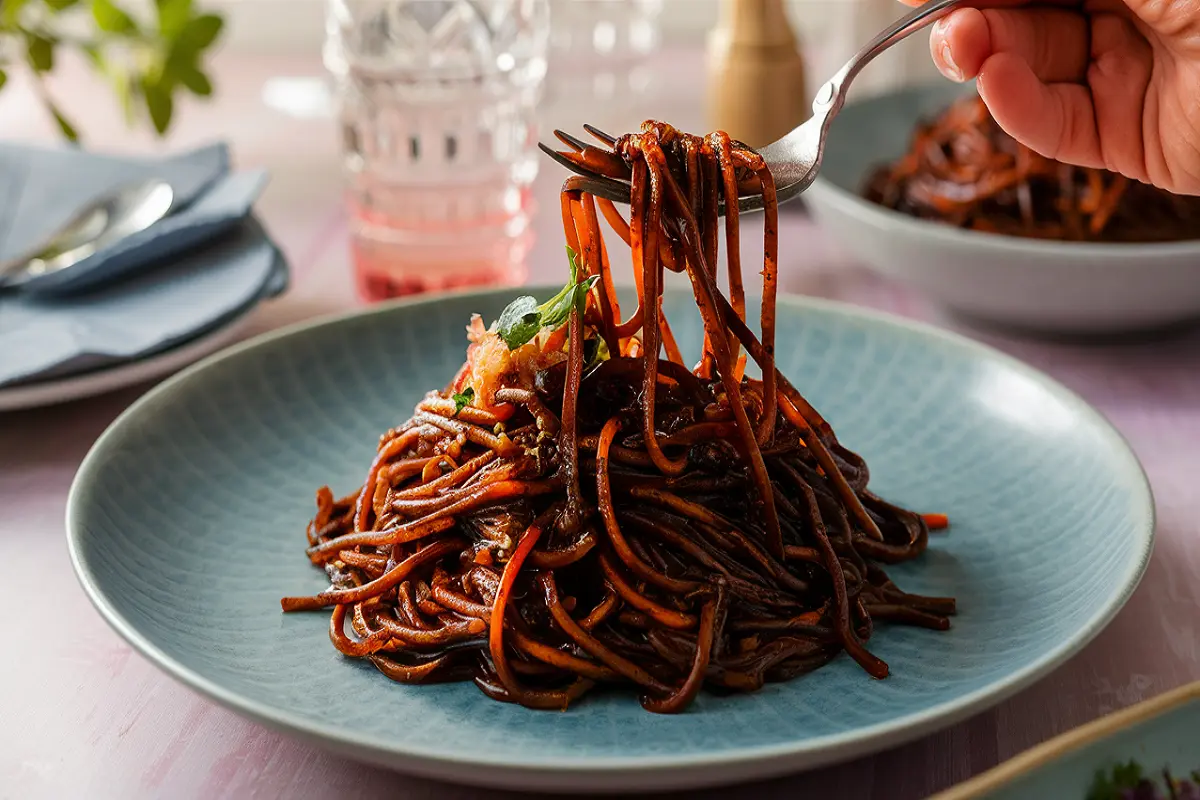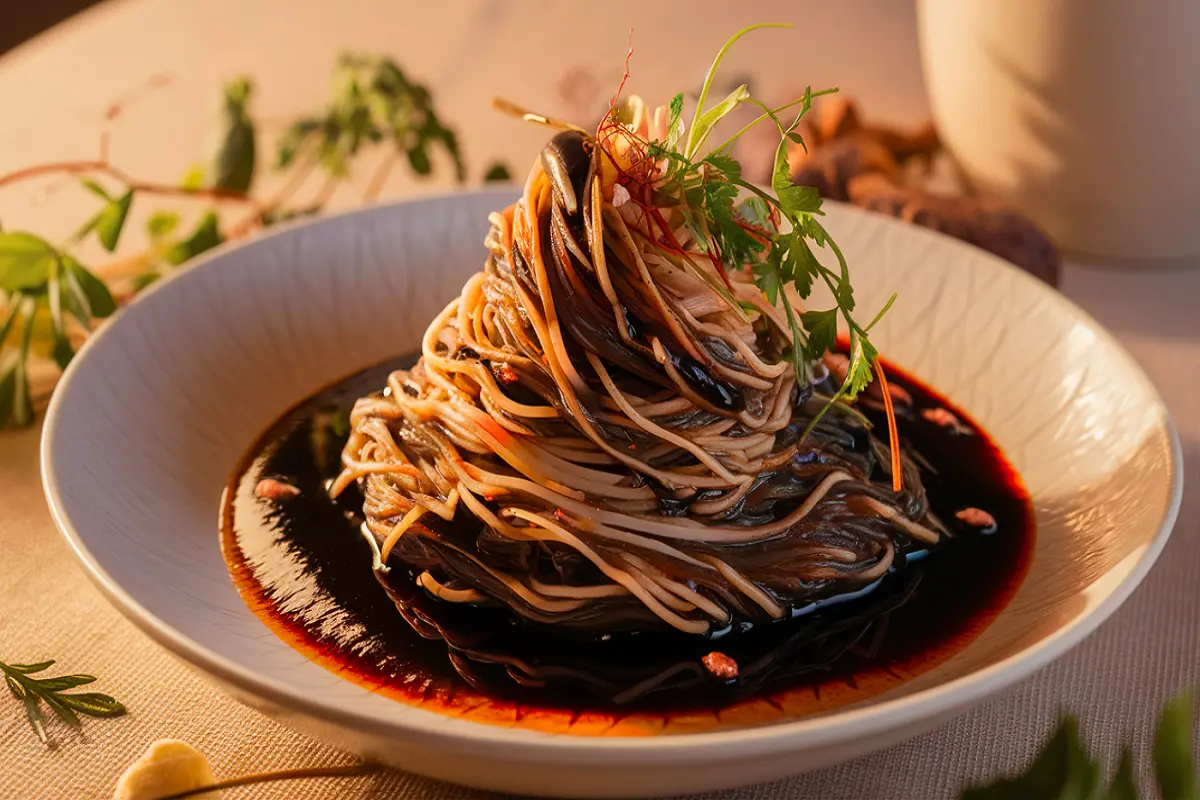Black bean noodles are a delightful dish that blends bold flavors and comforting textures. This recipe will guide you through every step to create a delicious, savory meal that’s satisfying, whether you’re cooking for yourself or preparing a dish for family or friends. The combination of hearty black beans and smooth, chewy noodles creates an umami-rich experience that will leave your taste buds dancing.
Ingredients Needed for Black Bean Noodles

Before diving into the preparation process, it’s essential to gather all the ingredients you’ll need. This will help ensure a smooth cooking experience.
Main Ingredients
- Black bean paste (or black bean sauce): ½ cup
- Noodles: 8 oz (preferably fresh or dried wheat-based noodles)
- Pork belly or chicken breast: ½ lb (optional for added flavor)
- Onion: 1 medium-sized, finely chopped
- Zucchini: 1 small, cut into thin slices or julienned
- Carrot: 1 medium, julienned
- Garlic: 4 cloves, minced
- Ginger: 1 tablespoon, minced
- Soy sauce: 2 tablespoons
- Oyster sauce: 1 tablespoon
- Cornstarch: 1 tablespoon, mixed with 2 tablespoons water for thickening
- Vegetable oil: 2 tablespoons for frying
- Salt and pepper: to taste
Toppings and Garnishes
- Cucumber: Julienned, for garnish
- Sesame seeds: 1 teaspoon, toasted
- Green onions: 2 stalks, chopped
- Red chili pepper: Thinly sliced for heat (optional)
- Soft-boiled egg: Halved, for extra richness (optional)
- Kimchi: On the side for a tangy contrast
Optional Protein Substitutes
If you prefer a vegetarian option, feel free to replace the pork belly or chicken breast with one of the following:
- Firm tofu: ½ lb, diced
- Mushrooms: ½ lb, thinly sliced
Step-by-Step Cooking Instructions for Black Bean Noodles
Now that you have all the ingredients ready, let’s get into the step-by-step process to prepare these flavorful black bean noodles.
1: Prepare the Noodles
- Boil the Noodles: Start by cooking the noodles. In a large pot, bring water to a boil. Once boiling, add the noodles and cook according to the package instructions. Fresh noodles usually cook faster, while dried noodles may take a few more minutes. Stir occasionally to prevent sticking.
- Drain the Noodles: Once the noodles are cooked to your preferred tenderness, drain them thoroughly in a colander. Rinse briefly with cold water to halt the cooking process and to remove excess starch. This helps the noodles maintain their chewy texture.
- Set Aside: Drizzle a small amount of vegetable oil over the noodles and toss them to prevent clumping. Set them aside while you prepare the black bean sauce and stir-fry components.
2: Prepare the Black Bean Sauce
- Heat the Oil: In a large skillet or wok, heat 2 tablespoons of vegetable oil over medium-high heat.
- Sauté Garlic and Ginger: Once the oil is hot, add the minced garlic and ginger. Sauté for 1 to 2 minutes until fragrant and golden, being careful not to burn them.
- Cook the Meat (If Using): If you’re using pork belly, chicken breast, or any protein, add it to the pan now. Stir-fry for about 5 to 6 minutes, or until fully cooked. The meat should be golden brown on the edges.
- Add the Vegetables: Add the finely chopped onion, zucchini, and carrot. Stir-fry for an additional 3 to 4 minutes until the vegetables start to soften but still retain a bit of crunch. This will create a lovely contrast in texture.
- Incorporate the Black Bean Paste: Add the ½ cup of black bean paste or sauce to the pan. Stir thoroughly to coat all the ingredients. Allow the sauce to cook for 2 to 3 minutes to develop its rich, savory flavor.
- Add Soy Sauce and Oyster Sauce: Pour in the soy sauce and oyster sauce, stirring to combine. These additional sauces add depth to the black bean sauce and balance its intensity.
- Thicken with Cornstarch: Stir the cornstarch mixture (1 tablespoon of cornstarch mixed with 2 tablespoons of water) into the pan. This will thicken the sauce, giving it a glossy finish and helping it cling better to the noodles.
- Season to Taste: Adjust the seasoning with salt and pepper according to your preferences. If the sauce tastes too strong, you can add a splash of water to dilute it slightly.
3: Combine Noodles with Sauce
- Add the Noodles to the Pan: Once the sauce has thickened and the flavors have melded together, it’s time to add the cooked noodles. Toss them in the black bean sauce, ensuring each strand is well coated.
- Cook for a Minute: Stir-fry the noodles in the sauce for about 1 to 2 minutes, allowing the noodles to absorb some of the sauce. This step helps the noodles become infused with the deep, savory flavors of the black bean sauce.
4: Serve the Black Bean Noodles
- Plating: Once the noodles are fully coated in the sauce, remove the pan from the heat. Using tongs or chopsticks, portion the noodles onto individual plates or bowls.
- Garnish: Top the noodles with julienned cucumber, chopped green onions, and a sprinkle of toasted sesame seeds. If you like extra heat, add a few slices of red chili pepper for a spicy kick.
- Optional Toppings: For added richness, you can serve the black bean noodles with a halved soft-boiled egg. Kimchi on the side will provide a refreshing contrast to the savory flavors of the dish.
5: Enjoy Your Black Bean Noodles
Congratulations! You have just prepared a delicious dish of black bean noodles. The noodles are now ready to be devoured, with the rich black bean sauce coating every strand, the vegetables adding a delightful crunch, and the garnishes offering fresh and tangy contrasts. Pair it with kimchi or pickled vegetables to enhance the flavor experience.
Customizing Your Black Bean Noodles
One of the great things about black bean noodles is their versatility. The recipe can be easily adjusted based on your preferences and dietary needs. Here are some ways to customize the dish to make it your own.
Choosing the Right Noodles
While this recipe uses wheat-based noodles, you can experiment with other types of noodles, such as:
- Rice noodles: For a gluten-free option, use rice noodles. They have a slightly different texture but still pair wonderfully with the black bean sauce.
- Udon noodles: These thick, chewy noodles provide a heartier base for the dish, absorbing the sauce even more.
- Soba noodles: Made from buckwheat, soba noodles offer a nutty flavor that complements the black bean sauce.
Vegetable Variations
You can get creative with the vegetables in this dish by incorporating other options, such as:
- Bell peppers: Thinly sliced for a pop of color and crunch.
- Spinach: Wilted at the end of cooking for added greens.
- Broccoli: Florets that add a slightly bitter note to balance the savory sauce.
Adjusting the Spice Level
If you enjoy a bit of heat in your dishes, feel free to spice up your black bean noodles by adding:
- Chili paste: Mix in a teaspoon or two of chili paste or gochujang for a spicy kick.
- Fresh chilies: Thinly sliced fresh chilies, like bird’s eye or jalapeño, can be added to the sauce or used as a garnish.
Protein Options
As mentioned earlier, this recipe works well with various proteins. Aside from pork belly and chicken breast, you can try:
- Shrimp or prawns: They add a slightly sweet and briny flavor to the dish.
- Beef strips: Thin slices of beef marinated in soy sauce and garlic provide a deeper, meatier flavor.
Tips for Perfect Black Bean Noodles

Cooking black bean noodles isn’t complicated, but these tips will ensure your dish comes out perfect every time.
Tip 1: Don’t Overcook the Noodles
Noodles that are too soft will break apart and lose their chewy texture. Cook them just until tender, then rinse them with cold water to stop the cooking process. Toss them with a little oil to prevent sticking.
Tip 2: Be Patient with the Sauce
Allow the black bean sauce to cook for a few minutes to deepen in flavor before adding the cornstarch slurry. This cooking time helps the sauce’s complexity develop and reduces any bitterness from the black bean paste.
Tip 3: Balance the Flavors
Black bean paste can be quite strong, so it’s essential to balance the dish with other ingredients like soy sauce, oyster sauce, and sugar (if needed). Taste the sauce as you go and adjust seasoning accordingly.
Tip 4: Keep It Fresh with Garnishes
The fresh, crisp garnishes, like cucumber and green onion, provide a refreshing contrast to the rich, heavy sauce. Don’t skip these—they elevate the dish and make it more well-rounded.
Frequently Asked Questions About Black Bean Noodles
1. Can I make black bean noodles ahead of time?
Yes, you can prepare black bean noodles ahead of time. Cook the noodles and the black bean sauce separately, and store them in airtight containers in the refrigerator. When you’re ready to eat, reheat the sauce and toss it with the noodles just before serving.
2. How do I store leftovers?
Store leftover black bean noodles in an airtight container in the fridge for up to 3 days. Reheat them in a pan over medium heat, adding a splash of water to loosen the sauce if needed.
3. Can I freeze black bean noodles?
It’s best to freeze the sauce separately from the noodles, as noodles can become mushy when thawed and reheated. Freeze the sauce in an airtight container for up to 2 months. When ready to serve, cook fresh noodles and mix with the thawed sauce.
4. Can I make this dish vegetarian or vegan?
Absolutely! Simply omit the meat or use tofu or mushrooms as a protein substitute. Ensure that the black bean paste and oyster sauce you use are vegetarian or vegan-friendly.
5. What should I serve with black bean noodles?
Black bean noodles are a hearty dish on their own, but they pair well with side dishes like kimchi, pickled radish, or a simple cucumber salad. A light, refreshing side balances the richness of the noodles.
Conclusion
Black bean noodles are a comforting, savory dish that’s easy to prepare and customize to suit your tastes. Whether you stick with the classic pork belly and black bean paste combination or explore vegetarian or spicy versions, this recipe provides a perfect base for a delicious meal. Follow the steps outlined here, and you’ll have a flavorful, well-balanced plate of noodles that’s sure to impress.
Enjoy the rich, umami-packed flavors, and don’t hesitate to experiment with different ingredients to make this dish uniquely your own!

